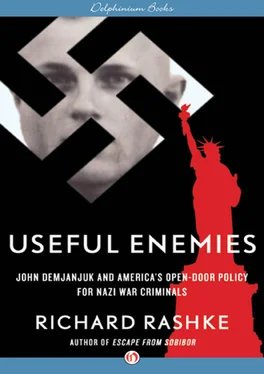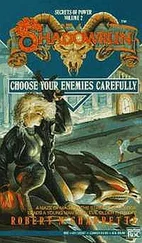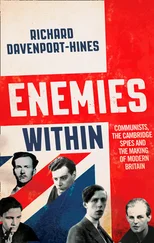The opportunity was to snatch them as war loot. The problem was how to prevent the Soviet Union from grabbing them first and how to prevent German scientists from rebuilding a Nazi movement in Nazi-friendly South America. What followed was a wild scramble for brains, documents, and materiel, the likes of which the world had never seen.
To make sure it got the lion’s share, the United States planned its hunt for loot as it would a vital military campaign—clearly defined, totally funded, and fully manned. It set up T-teams ( T meaning “Target”), or T-forces, composed of specialists who posed as civilians when needed—three thousand men trained in languages, document retrieval, and every scientific discipline from chemistry to physics. There were troops for kidnapping, doctors for interrogation, engineers for dismantling labs, bomb squads for disarming. The teams were given unprecedented authority to commandeer planes, ships, trains, trucks, and cash. Each team received a specific target—a named scientist, a university, a factory or lab. Mobile units directed the teams to their targets, even dropping kidnap squads behind enemy lines.
The initial idea in the months before the war ended was to vacuum the brains of important scientists. But the program quickly changed after the war. Why just interview? Why not offer these people high-paying jobs in America, guarantee them and their families U.S. citizenship, and set them to work on tempting new projects? You were a war criminal? Not a problem. We will protect you.
The Soviets were doing the same thing in what was called Operation Osavakim, but with a twist. They arrested as war criminals all the Reich scientists they could find, then loaded them on trains. Once in Moscow, they gave their war spoils a choice. Work for us and we’ll pay you twice as much as a Soviet scientist gets, or go to Siberia and work for bread and soup.
“Competition is fierce,” one observer put it mildly. Highly trained American teams would sneak into French, British, and Soviet zones in Germany and Austria to kidnap scientists. And the army, air force, and navy began “stealing from” each other in competing operations with code names like Backfire, Safehaven, Overcast, Lusty, and National Interest.
In the end, the United States came out the big winner. It captured prototypes of every conceivable war vehicle, weapon, and device—Walter submarines, thirty-nine different airplanes, partially assembled V-2 rockets, sophisticated bombsights. It took samples of poison gas and dismantled and reassembled whole chemical warfare labs. It appropriated nearly four hundred tons of documents and it microfilmed another four million pages, including patent applications.
While the highly funded and focused T-teams were finding, kidnapping, and interrogating German and Austrian scientists for their export value, the Army’s Counter Intelligence Corps (CIC) was wrestling with two interrelated tasks: to denazify more than 120,000 SS officers, Gestapo, and high-ranking military leaders in the American zone, and to find the suspected war criminals among them. In contrast to the planning, urgency, and organization of war spoils operations, both CIC tasks were underplanned, understaffed, underfunded, and underled.
On paper, denazification was simple. Find the SS officers, Gestapo, and high-ranking military officers, secure and interview them, then place them in one of five categories: major war crimes offender, offender, lesser offender, follower, and exonerated person. The CIC used the Seventh Army to conduct Nazi sweeps in the American zone under code names like Tally Ho, Lifebuoy, and Choo Choo.
The sheer magnitude of the effort was daunting.
So was the mandate to find suspected war criminals. Thousands of them had strolled out of makeshift and underguarded holding pens. They wandered back home or hitched rides on ratlines to the Middle East and South America. Furthermore, the Pentagon failed to design a system to locate and question the hundreds of thousands of war crimes eyewitnesses trapped in DP camps. There were no T-teams with specific targets, no mobile units to guide them, no top-priority status with the authority to commandeer. The task was impossible. And that was no accident.
Even before the war was over, the Pentagon approached the war crimes issue with amoral pragmatism. It instructed General Eisenhower, commander of U.S. forces in Europe, to arrest and hold all war criminals. Then it instructed him to exempt those war criminals who could be used for “intelligence and military reasons.”
This clear, deliberate dichotomy between finding, shielding, and employing Nazi scientists with urgency, efficiency and capital on the one hand, and finding, exposing, and punishing war criminals with confusion, disorganization, and lack of resources on the other became the postwar mind-set of the Washington bureaucracy dominated by the military. It was the root of U.S. hostility toward finding and investigating Nazis hiding in America.
CIC investigators worked with dedication and speed. A U.S. denazification tally issued in September 1946—sixteen months after the war ended—reported that the CIC had registered and categorized more than eleven million Germans. Of those, more than one hundred thousand were eventually charged with war crimes. Few, if any, of the hundred thousand were Nazi collaborators or other war criminals living in DP camps in the American zone.
• • •
Needless to say, it wasn’t the prototype subs, airplanes, nerve gas, and weaponry that the United States lusted after, as useful as they were. The War Department wanted the scientists who had created them. Once it found them, it had to craft a subterfuge to sneak them into the United States. To cover their tracks, the military and the State Department sent covert agents dressed in army and air force uniforms to infiltrate the CIC in Europe. Their job was to “smoothly and conspiratorially” expunge the names of its targeted scientists from the Central Registry of War Criminals and Security Suspects (CROWCASS) and to make sure that the CIC did not issue any “derogatory information” reports on them. ( Derogatory information was bureaucratese for suspicion of war crimes.) Then, to make sure there would be no embarrassing problems later on, the covert agents created false employment histories and political bios for each target. Scrubbed clean and with new identities, the scientists were loaded on planes, listed as “cargo,” and flown to the United States.
In approving the postwar military talent grab, President Truman made a clear distinction between Nazis and SS officers who had committed war crimes, and “normal” Nazis who had joined the party merely to advance their careers or who had accepted positions as a reward for their achievements. This latter group fell in the CIC category of “follower.”
Truman welcomed followers to the United States, and then authorized the military to make the scientist program public. Three months after the war ended, the Department of War issued a press release: “The Secretary of War has approved a project whereby certain outstanding German scientists and technicians are being brought to this country to ensure that we take full advantage of those significant developments which are deemed vital to our national security.” The War Department also released photos of smiling American and German scientists working side by side.
Other than short-lived shouts of anger from Jewish organizations that suspected there was more to the German scientists than science, Americans accepted the employment of German and Austrian scientists with can-do pragmatism. The old war was over. The new war had begun. It was time for all anticommunists to work together with determination and harmony to defeat the new enemy. Let’s put a man on the moon. And God bless America.
Читать дальше












